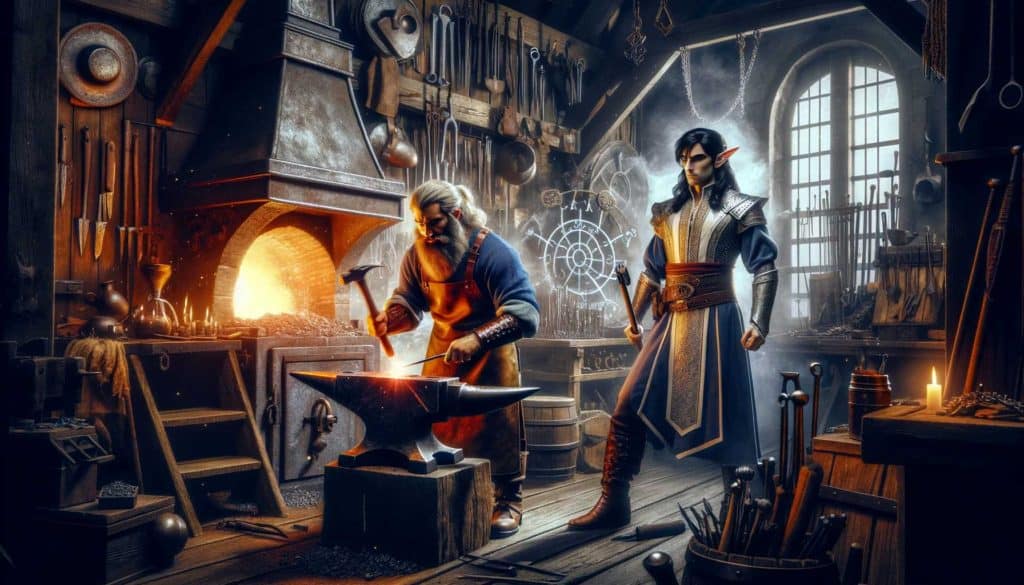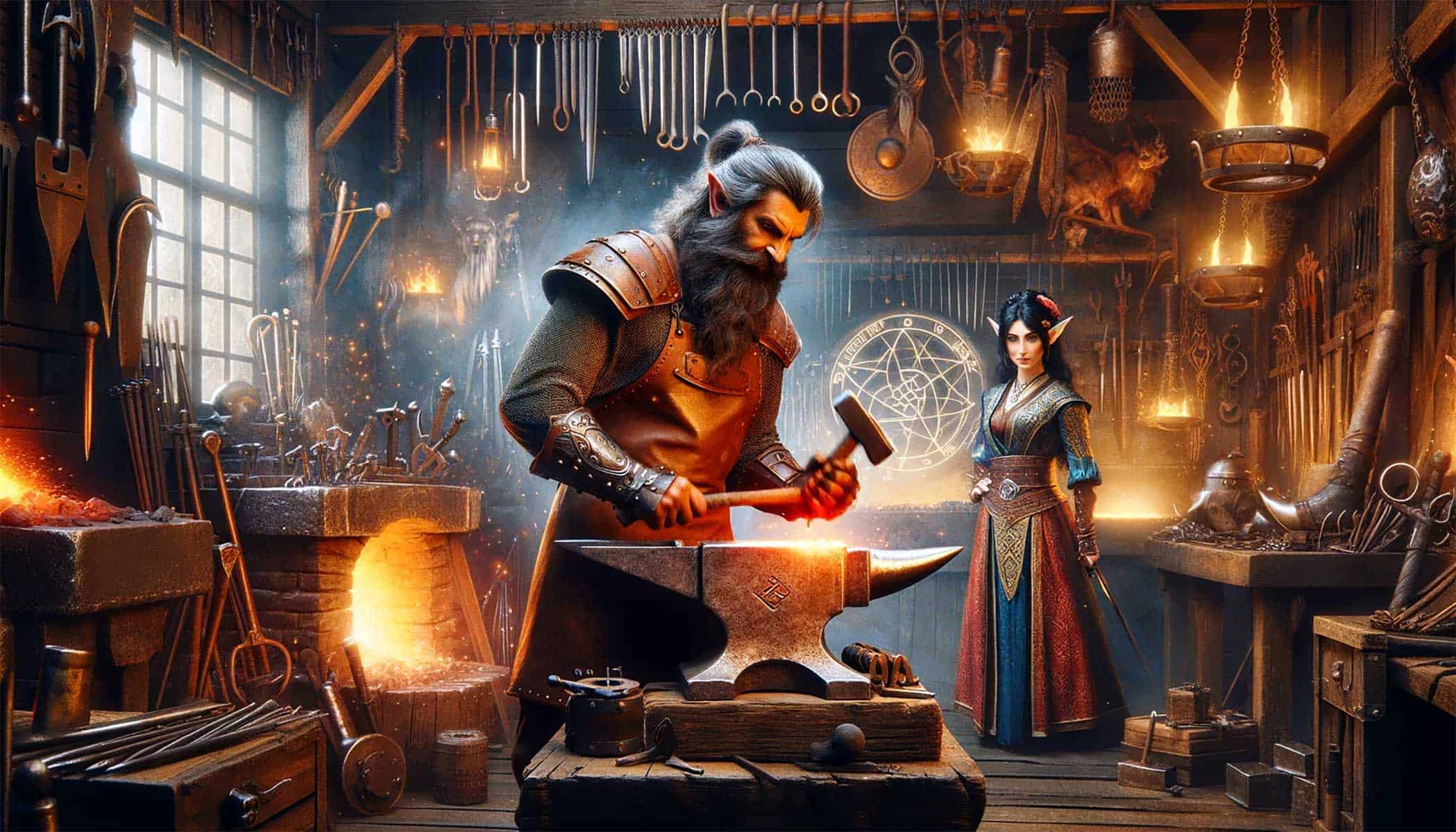In the realm of Dungeons & Dragons (D&D), the clang of sword against shield and the whisper of an arrow in flight are the heartbeat of adventure. Weapons are more than mere tools; they are the companions of heroes, the enforcers of quests, and the great equalizers facing the unknown dangers lurking in dungeons deep and caverns old. For the beginner embarking on a journey into the world of D&D 5e, understanding the panoply of available armaments is key to survival and success.
As a starting adventurer, the array of weapons presented can be as bewildering as a spellcaster’s grimoire. From simple clubs to elegant swords, each weapon serves a purpose and complements the strengths of different classes and characters. Whether it’s a ranger’s bow, a rogue’s dagger, or a paladin’s greatsword, the weapons of D&D are an extension of the character’s will and a reflection of their style.
Weapon Categories
In the realm of Dungeons & Dragons 5th Edition, every aspiring hero or cunning villain must understand the various types of weapons at their disposal. These armaments are categorized broadly into simple and martial weapons, each with its own characteristics, examples, and use cases.
Simple Weapons
Simple weapons are the basic arms that require no special training to wield effectively. These are the weapons that common folk might have on hand or that adventurers can easily pick up and use without extensive practice. Simple weapons are often less damaging than their martial counterparts, but they can be just as effective in the right hands. They typically offer straightforward functionality without the added complexity of advanced combat techniques.
Examples of simple weapons include clubs, daggers, and slings. A club, for example, is nothing more than a piece of wood shaped to fit comfortably in the hand and capable of delivering a solid blow. A dagger is a staple for any class, offering a quick, light option that is easily concealed. Simple weapons are ideal for spellcasters like wizards and clerics who may need a weapon but typically focus on their magical abilities, or for characters like rogues who appreciate a weapon’s ease of handling for stealth and speed.
Martial Weapons
Martial weapons, in contrast, are more sophisticated and require specific training to use effectively. These weapons are typically associated with warrior classes like fighters, paladins, and barbarians, who have honed their martial prowess. Martial weapons include a wider variety of types and typically have greater damage potential, offering strategic options that can be leveraged in combat to achieve different effects.
Try my AI Tabletop RPG generators...and an extensive library of content!
Swords, battleaxes, and longbows fall under the category of martial weapons. Each of these requires a level of expertise that comes from training, whether it’s knowing the precise way to strike with the edge of a blade or draw a bow for maximum impact. The specialized training also means that certain classes will be better suited to certain martial weapons, depending on their fighting style and role within the party. A fighter, for instance, might excel with a greatsword, capitalizing on its heavy damage, while a ranger would likely prefer the longbow’s ability to strike from a distance.
Understanding the differences between simple and martial weapons is crucial for any adventurer. Choosing the right weapon can mean the difference between victory and defeat, between a successful campaign and an untimely demise. As adventurers progress and encounter more challenging foes, the weapons they choose will become ever more integral to their survival and success.
Simple Weapons Breakdown
In the world of Dungeons & Dragons, not all weapons require the mastery of a seasoned warrior. Simple weapons are those that anyone, from the common villager to the aspiring adventurer, can pick up and use without extensive training. These weapons are fundamental to various character builds and can be surprisingly effective in combat. Let’s delve into the characteristics of a few standout simple weapons and uncover which classes might best utilize them to their advantage.
Rapier
The rapier is a weapon of finesse, designed for quick thrusts and elegant combat. Lightweight and precise, it can deal a substantial 1d8 piercing damage, all while maintaining the maneuverability of lighter blades.
⚔️ Fantasy RPG Random Tables Books
Make life as a Gamemaster easier…
If you play Dungeons & Dragons, Pathfinder, or other fantasy RPGs, this
RPG random tables series
is packed with encounters, NPCs, treasure, and more. Available in eBook or print—either way, you’ll have a wealth of adventure ideas at your fingertips.
Best Use Cases and Class Fit: Rapiers are ideal for characters who prioritize agility over brute strength. Classes such as Rogues, particularly those following the Swashbuckler archetype, can make excellent use of the rapier, leveraging both their Dexterity for attacks and their flair for dramatic duels.
Quarterstaff
Simple in its make but versatile in its use, the quarterstaff is a long, sturdy pole that can be wielded one-handed or two-handed. Its versatile nature allows for a 1d6 bludgeoning damage when used with one hand and a 1d8 when used with both.
Aesthetics and Versatility: Often seen in the hands of monks or wizards, a quarterstaff can range from a basic wooden rod to an ornately carved symbol of power. Its balance and reach make it a practical choice for those who value adaptability in their weapon.
Preferred Classes for Quarterstaff Use: Monks find the quarterstaff to be particularly effective, as it complements their martial arts style. Wizards and Druids also frequently use it, not only as a weapon but also as a conduit for their magical energies.
Longbow
The longbow is a formidable weapon that allows attacks from a great distance, offering an impressive range and the potential for considerable damage with a 1d8 piercing hit.
Range and Ammunition Rules: A longbow has a significant reach, allowing attacks from 150 feet away without disadvantage, and up to 600 feet at a disadvantage. Arrows must be recovered post-battle, with half the spent ammunition retrievable with a quick search of the battlefield.
Restrictions for Small and Tiny Creatures: The longbow’s size and heft mean that smaller characters, like Halflings and Gnomes, may struggle with its use, having disadvantage due to the bow’s heavy property. However, larger races will find the longbow an essential tool for ranged combat, perfect for Rangers and Fighters who specialize in archery.
Martial Weapons Breakdown
Martial weapons in Dungeons & Dragons are designed for those with specialized combat training, allowing for more diversity in attack styles and greater damage potential. Unlike simple weapons, they generally require proficiency for effective use, which various classes can offer. Here we’ll explore a range of martial weapons, each with unique features that can cater to different aspects of combat and character development.
Dagger
The dagger is far more than just a basic stabbing tool; it’s a weapon of subterfuge and utility. Its small size makes it easy to conceal, providing an edge in situations where discretion is necessary.
Utility and Concealment: A dagger’s diminutive form allows it to double as a tool in various scenarios, from cutting ropes to picking locks when proper tools are absent. This is very useful for rogues, as you might imagine.
Finesse Property and Ideal Classes: With its finesse property, the dagger can use either Strength or Dexterity for attack rolls, making it a versatile choice for Rogues and Bards who might rely more on agility than raw power.
⚔️ Fantasy RPG Random Tables Books
Make life as a Gamemaster easier…
If you play Dungeons & Dragons, Pathfinder, or other fantasy RPGs, this
RPG random tables series
is packed with encounters, NPCs, treasure, and more. Available in eBook or print—either way, you’ll have a wealth of adventure ideas at your fingertips.
Light Crossbow
The light crossbow brings mechanical sophistication to ranged combat with its loading property, which necessitates a hand free to load a bolt for each shot.
Mechanical Aspects and Loading Property: The loading aspect implies that characters with the Extra Attack feature can’t use it more than once on their turn without the Crossbow Expert feat.
Comparison with Hand and Heavy Crossbows: While the hand crossbow allows for easier mobility and the use of a shield or another weapon in the other hand, the heavy crossbow offers greater damage output but at the cost of mobility due to its heavy property.
Greatsword
The greatsword is a two-handed weapon capable of dealing significant damage, thanks to its large size and the power behind its strikes.
Damage Potential and Size Considerations: A greatsword deals 2d6 slashing damage, making it one of the highest damage-dealing weapons available for players, particularly effective in the hands of characters who can maximize their number of attacks.
Cost-Benefit Analysis and Racial Preferences: While costly and requiring two hands, its damage output makes it a favored weapon among races that boast strength bonuses, such as Orcs and Dragonborn.
Javelin
As a versatile weapon, the javelin offers both melee and ranged combat options. It’s inexpensive and can be thrown as part of a ranged attack.
Price, Damage, and Retrieval Mechanics: Javelins are relatively cheap, making them accessible for characters of all classes. They deal 1d6 piercing damage and can typically be retrieved after a battle unless they are broken or lost.
Comparisons with Similar Weapons like the Quarterstaff: While a quarterstaff is versatile in its damage type and use with two hands, the javelin excels in its dual capability as a melee and thrown weapon, offering combatants greater flexibility in combat positioning.
Scimitar
The scimitar, with its distinctive curved blade, has roots in historical Middle Eastern warfare and is designed for slashing rather than stabbing.
Design and Historical Context: This curvature allows for a swift, fluid fighting style and was historically favored by cavalry due to its slashing potential.
Finesse Property and Advanced Options like the Double-Bladed Scimitar: In D&D, the scimitar is a light, finesse weapon, making it suitable for classes like Rogues and Rangers. For those looking for an exotic twist, the double-bladed scimitar adds flair and damage possibilities, though it is typically restricted to specific campaign settings or character backgrounds.

Conclusion: Common DnD weapons for 5e
As we wrap up this exploration of weapon choices in Dungeons & Dragons, it’s important for beginners to recognize the wide array of options available to them. From the unassuming simplicity of the quarterstaff to the formidable presence of a greatsword, each weapon brings a unique set of characteristics to the table.
Starting with simple weapons like the rapier and longbow offers a foundation that’s easy to handle and effective in various situations. Moving into martial weapons, beginners can encounter more nuanced properties like finesse with daggers and scimitars, the balance of damage and utility with javelins, or the raw power of a greatsword.
Choosing a weapon should be a reflection of your character’s class, strengths, and your preferred playstyle. Whether you enjoy the stealthy and tactical maneuvers of a Rogue with a dagger or the brute strength of a Fighter swinging a greatsword, your weapon not only complements your character but also defines your role within your adventuring party.
As characters progress through their adventures, the weapons they wield may begin as mere steel but can become legends in their own right. The journey from common to magical or legendary weapons is a storied path in D&D. Magical weapons carry potent enchantments, offering everything from elemental damage to spells that can be cast from them. Legendary weapons often have rich histories and are tied to significant events or figures in the lore of the land.
Whether you start with a simple sling or aspire to wield a legendary sword that’s as much a character as any player at the table, remember that the true magic of D&D weapons lies not just in their in-game statistics but in the stories they help to create. Your choices will shape your narrative and your character’s legacy in the rich tapestry of the game.










